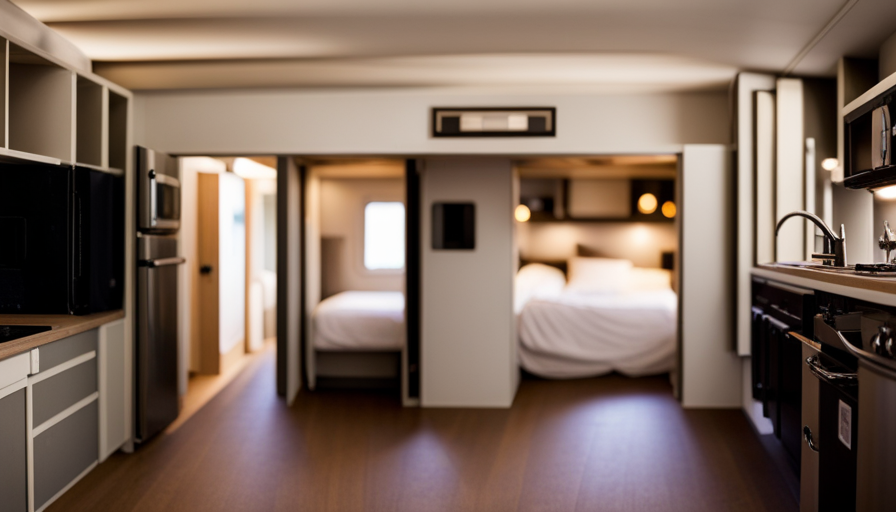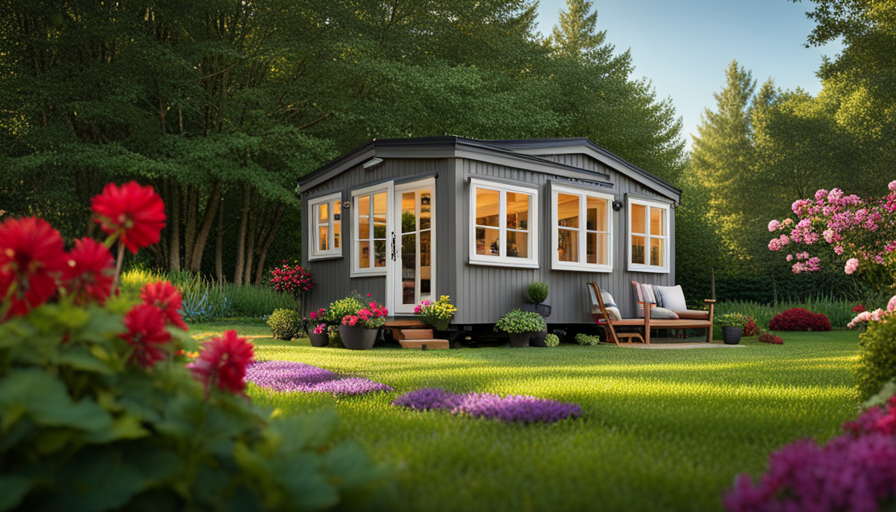In the vast world of alternative energy options for small homes, propane stands out as a reliable and versatile option. Serving as a heat source during cold nights, propane can power various appliances and systems in these compact residences. But the question remains: How much of this valuable fuel is needed to effectively run your tiny home? Join us as we delve into the details of propane usage in the realm of small homes.
As a fuel source, propane offers an array of benefits but understanding its usage requirements is essential. From heating and cooking to powering other appliances, every aspect plays a crucial role in determining your propane needs. By exploring factors such as weather conditions, insulation quality, appliance efficiency, and personal preferences, we can calculate the ideal amount of propane required.
With safety considerations at the forefront, we will also delve into choosing the right tank size for your tiny house. Additionally, we will explore alternative fuel options that could potentially offer greater sustainability or cost-efficiency.
So let’s dive into this comprehensive guide and find that perfect balance between comfort and conservation in our tiny abodes!
Key Takeaways
- Propane is a reliable and versatile fuel source for tiny houses.
- Factors such as weather conditions, insulation quality, appliance efficiency, and personal preferences determine propane needs.
- Safety precautions include proper ventilation, carbon monoxide detectors, and secure connections.
- Propane costs can be estimated based on consumption and the cost per gallon.
Understanding Propane as a Fuel Source for Tiny Houses
If you’re considering propane as a fuel source for your tiny house, you’ll be amazed at how versatile and efficient it can be! Propane is a clean-burning and portable fuel that provides heat, hot water, cooking, and even refrigeration in some cases. However, it’s important to understand the safety precautions associated with using propane in your tiny house.
Firstly, always ensure proper ventilation when using propane appliances to prevent carbon monoxide buildup. Install carbon monoxide detectors and regular maintenance checks are essential to keep your living space safe. Additionally, make sure all connections and hoses are tightly secured to avoid gas leaks.
When it comes to the environmental impact of propane usage, it’s generally considered cleaner than other fossil fuels like oil or coal. Propane combustion produces lower levels of greenhouse gases and harmful emissions such as sulfur dioxide or particulate matter. However, it’s still crucial to use energy-efficient appliances and minimize overall consumption to reduce environmental impact further.
Moving forward into factors affecting propane consumption in a tiny house, several variables come into play. These include insulation quality, climate conditions, appliance efficiency ratings, thermostat settings, and daily usage habits. By carefully managing these factors and making informed choices about your appliances’ energy efficiency levels, you can optimize your propane consumption without compromising comfort or convenience.
Factors Affecting Propane Consumption in a Tiny House
One cannot underestimate the impact of various factors on how much propane a tiny home consumes. Factors influencing propane consumption in a tiny house are crucial to optimize its usage and ensure efficient fuel management.
Here are three key considerations that play a significant role in determining the amount of propane used:
-
Climate: The climate in which a tiny house is located greatly affects its propane consumption. Colder regions require more heating, leading to higher propane usage, while milder climates may necessitate less.
-
Insulation: Proper insulation helps retain heat within the tiny house, reducing the need for constant heating and minimizing propane consumption. Well-insulated walls, floors, and roofs contribute to energy efficiency.
-
Appliance Efficiency: The energy efficiency of appliances using propane, such as heaters and stoves, directly impacts consumption. Choosing high-efficiency devices can significantly reduce the amount of propane required for daily activities.
By considering these factors influencing propane consumption and optimizing propane usage through climate adaptation, insulation improvements, and appliance efficiency enhancements, one can effectively manage fuel needs in a tiny house. Calculating propane needs for heating and cooking requires careful evaluation based on these considerations to ensure optimal resource utilization without compromising comfort or functionality in your small dwelling transition.
Calculating Propane Needs for Heating and Cooking
To accurately determine the amount of propane required for heating and cooking, it’s essential to calculate the specific needs based on factors like climate, insulation, and appliance efficiency. When it comes to heating, a key factor is the climate in which the tiny house is located. Colder regions will require more propane for heating compared to warmer areas. Insulation also plays a crucial role in propane consumption as well-insulated tiny houses retain heat better, reducing the need for excessive propane usage.
In terms of cooking, the type of appliances used and their efficiency are important considerations. Propane stoves and ovens offer precise temperature control and faster cooking times compared to electric alternatives. This means that less propane is needed overall.
Calculating propane costs can be done by estimating the average consumption per day or month based on historical data or manufacturer specifications. By multiplying this by the cost per gallon of propane, you can determine your approximate monthly expenses.
Using propane in a tiny house brings several benefits such as energy efficiency, cost-effectiveness, and reduced environmental impact compared to other fuel sources. Additionally, having additional uses for propane in a tiny house such as water heating or powering generators provides further versatility.
Moving forward into discussing additional uses for propane in a tiny house…
Additional Uses for Propane in a Tiny House
Discover the versatile ways you can utilize propane in your compact living space for a more efficient and convenient lifestyle. Propane offers a wide range of additional uses in a tiny house beyond just heating and cooking.
One benefit of propane appliances is their energy efficiency, which is crucial in a smaller living space where every square inch matters. Propane-powered refrigerators are an excellent choice for keeping your food fresh without taking up valuable electricity. These appliances also work well off-grid, making them perfect for those who want to live sustainably.
Another great use for propane in a tiny house is water heating. Propane water heaters are highly efficient and can provide hot water on demand, ensuring that you never run out during your morning shower or dishwashing sessions. Additionally, using propane as fuel for your clothes dryer allows for faster drying times and reduces the risk of mold growth due to excess moisture.
Incorporating additional propane appliances into your tiny house brings numerous benefits such as energy efficiency, off-grid capabilities, and convenience. In the next section about choosing the right propane tank size, we will explore how to determine the appropriate capacity based on your specific needs.
Choosing the Right Propane Tank Size
Optimize your propane tank size to ensure uninterrupted supply and enhance the efficiency of your cozy living space. Choosing the right propane tank capacity is crucial for a tiny house, as it directly impacts how frequently you need to refill your tank. The size of your propane tank will depend on various factors such as the number of appliances using propane, their BTU ratings, and your usage patterns.
For a typical tiny house with basic appliances like a stove, water heater, and furnace, a 20-pound propane tank should be sufficient. This size can last for approximately 2-4 weeks before needing a refill. However, if you have additional appliances or plan on using propane for heating purposes extensively, you might want to consider larger tanks such as 30 or even 40 pounds.
It’s essential to strike a balance between having enough capacity to avoid frequent refills while also considering space constraints in a tiny house. Remember that larger tanks may require more storage space and can add weight to your overall setup.
Choosing the right propane tank size depends on understanding your specific needs and usage patterns. By optimizing this aspect, you can minimize disruptions caused by frequent refills and maximize the efficiency of your tiny house living experience.
Transitioning into tips for efficient propane usage in a tiny house: Now that we’ve covered selecting the appropriate tank size…
Tips for Efficient Propane Usage in a Tiny House
Maximize the coziness of your compact living space by implementing smart strategies for efficient propane usage in your tiny abode. When it comes to maximizing efficiency and reducing propane costs, there are a few key tips to keep in mind.
Firstly, consider insulating your tiny house properly. Good insulation helps retain heat and prevents wastage of propane. Make sure all windows and doors are properly sealed to avoid any drafts that could lead to heat loss.
Additionally, using energy-efficient appliances can make a significant difference in propane consumption. Look for appliances with high Energy Star ratings as they’re designed to use less energy without compromising performance.
Another pro tip is to be mindful of temperature control. Set your thermostat at an optimal temperature that keeps you comfortable without excessive heating or cooling. A programmable thermostat can help regulate the temperature automatically, ensuring efficient propane usage throughout the day.
Lastly, regular maintenance of your propane system is crucial for optimum efficiency. Schedule periodic inspections and cleanings to ensure everything is working properly and efficiently.
By following these tips, you can maximize the efficiency of your propane usage while reducing costs. Transitioning into the subsequent section about safety considerations for propane usage, it’s important to understand how to handle this fuel safely in order to fully enjoy its benefits without any risks involved.
Safety Considerations for Propane Usage
Ensure your safety and peace of mind while using propane in your compact living space by taking proper precautions and following essential guidelines.
Propane is a highly flammable gas, so it’s crucial to prioritize safety at all times. Start by installing carbon monoxide detectors in your tiny house to detect any leaks or buildup of this odorless gas.
Additionally, make sure that your propane tank is stored in a well-ventilated area outside the house, away from any ignition sources.
When it comes to propane storage guidelines, always keep the tank upright and secure it with straps or brackets to prevent tipping over. Regularly inspect the tank for any signs of damage or corrosion and have it professionally inspected if needed. It’s also important to have a fire extinguisher readily available and know how to use it properly.
To further enhance safety, consider using a propane leak detector that’ll alert you if there are any leaks in your system. Ensure that all propane appliances are installed correctly by professionals and follow the manufacturer’s instructions for maintenance and operation.
Adhering to these propane safety precautions and storage guidelines will help ensure a safe living environment in your tiny house.
Now let’s explore the pros and cons of using propane as a fuel source for compact dwellings without compromising on comfort or functionality.
Pros and Cons of Propane as a Fuel Source for Tiny Houses
Living off the grid in a compact space has its advantages and disadvantages, and one factor to consider is the use of propane as a fuel source. When it comes to powering a tiny house, there are two main options: propane or electricity.
Propane offers several benefits for tiny houses. Firstly, it is cost-effective compared to electricity. Propane appliances tend to be more energy-efficient, resulting in lower utility bills. Additionally, propane can be stored in tanks, allowing for greater independence from the electrical grid.
Propane also provides versatility in terms of usage. It can power various appliances such as stoves, water heaters, and refrigerators efficiently. Furthermore, propane can be used for heating purposes during colder seasons, ensuring comfortable living conditions inside the tiny house.
However, there are some drawbacks to using propane as well. One concern is safety since propane is highly flammable and must be handled with caution. Regular maintenance of propane systems is necessary to prevent leaks or malfunctions that could pose a risk.
While there are pros and cons to using propane as a fuel source for tiny houses when compared to electricity, its cost-effectiveness and versatility make it an attractive option for many homeowners. Transitioning into alternative fuel options for tiny houses allows us to explore other possibilities beyond just relying on propane alone without compromising functionality or comfort within these small living spaces.
Alternative Fuel Options for Tiny Houses
Now that we’ve discussed the pros and cons of propane as a fuel source for tiny houses, let’s explore some alternative fuel options. As a tiny house owner, it’s important to consider different alternatives to propane in order to find the most suitable option for your specific needs.
When it comes to alternative fuel options for tiny houses, there are several choices available. These include:
-
Electricity: This is a popular choice among tiny house owners, as it provides a clean and convenient source of energy. However, it’s important to note that electricity can be more expensive than propane in some cases.
-
Solar Power: Harnessing the power of the sun through solar panels is another eco-friendly option for powering your tiny house. While this may require an initial investment, solar power can be cost-effective in the long run.
-
Wood: If you’re looking for a traditional and sustainable fuel option, wood could be a viable choice. Wood stoves are efficient at heating small spaces and can also provide a cozy ambiance.
When considering alternative fuel options for your tiny house, it’s crucial to compare their costs and benefits. This will help you make an informed decision based on your budget and energy requirements.
Finding the right balance of propane usage in your tiny house requires exploring alternative fuel options such as electricity, solar power, and wood. By weighing their costs and benefits, you can choose the most suitable option for your unique needs.
Conclusion: Finding the Right Balance of Propane Usage in Your Tiny House
To achieve the perfect harmony in fuel usage for your compact abode, finding the right balance between propane and alternative options is key. When it comes to powering a tiny house, propane is often the go-to choice due to its versatility and efficiency. However, relying solely on propane can be costly in the long run. Therefore, it’s important to consider finding alternative fuel sources that can help reduce your overall propane consumption.
One option to explore is solar power. Installing solar panels on the roof of your tiny house can provide a sustainable source of energy for various appliances and systems, such as lighting and heating. This can significantly decrease your reliance on propane for these purposes.
Another alternative fuel option worth considering is wood-burning stoves or pellet stoves. These are not only cost-effective but also environmentally friendly alternatives to propane heaters. They can efficiently heat up your tiny house while adding a cozy ambiance.
When calculating the cost of propane usage, it’s essential to factor in both the initial investment and ongoing expenses associated with refilling tanks or cylinders regularly. By finding alternative fuel sources and using them strategically alongside propane, you can strike a balance that maximizes efficiency while minimizing costs in your tiny house journey.
Frequently Asked Questions
What are the different types of propane tanks available for tiny houses?
There are several different types and sizes of propane tanks available for tiny houses. The most common types include vertical, horizontal, and underground tanks.
Vertical tanks are typically used for above-ground installation and come in various sizes ranging from 20 to 100 gallons.
Horizontal tanks are ideal for limited space and are available in sizes between 30 and 250 gallons.
Underground tanks provide a discreet option and can hold up to 1,000 gallons of propane.
Can propane be used for powering appliances like refrigerators and water heaters in a tiny house?
Using propane as an alternative energy source in a tiny house has its pros and cons. On one hand, propane can power appliances like refrigerators and water heaters efficiently, providing reliable hot water and keeping food fresh.
However, it’s important to consider the storage and safety aspects of using propane. Propane tanks are available in different sizes for various needs, but determining the right amount of propane for a tiny house depends on factors such as appliance usage and climate conditions.
Are there any regulations or permits required for installing a propane tank in a tiny house?
Regulations for installing propane tanks in tiny houses include obtaining permits and complying with local building codes. Safety precautions for using propane in tiny houses are crucial to prevent accidents. It’s important to install the propane tank properly, ensuring it’s securely fastened and protected from damage. Regular inspections and maintenance of the system should be carried out to detect any leaks or malfunctions. Additionally, proper ventilation is essential to prevent the build-up of potentially hazardous gases.
How often should a propane tank be refilled or replaced in a tiny house?
Propane tank maintenance in a tiny house is crucial to ensure uninterrupted fuel supply. The frequency of refilling or replacing the propane tank depends on its size and usage. It’s important to consider the propane tank size when determining how often it needs to be refilled or replaced.
Regular inspection for leaks, proper ventilation, and following manufacturer guidelines are essential for safe operation. Consult a professional for accurate recommendations based on your specific setup.
What are the potential risks or dangers associated with using propane in a tiny house?
What are the potential risks or dangers associated with using propane in a tiny house?
Propane, although an efficient fuel source, poses certain safety hazards. Improper installation or handling can result in gas leaks, leading to fire or explosion. To mitigate these risks, it’s crucial to ensure proper ventilation and regular inspection of propane systems.
Implementing safety measures such as installing carbon monoxide detectors and fire extinguishers can further enhance the overall safety of a tiny house using propane.
Conclusion
In conclusion, after considering the various factors affecting propane consumption in a tiny house and understanding its uses for heating, cooking, and more, it’s crucial to choose the right propane tank size.
Safety should always be prioritized when using propane as a fuel source, and it’s essential to weigh the pros and cons of this option. However, there are alternative fuel options available for tiny houses.
As the saying goes, "Knowledge is power," so make an informed decision that suits your needs while finding the right balance of propane usage in your tiny house.
Hi, I’m Emma. I’m the Editor in Chief of Tiny House 43, a blog all about tiny houses. While tree houses are often associated with childhood, they can be the perfect adult retreat. They offer a cozy space to relax and unwind, surrounded by nature. And since they’re typically built on stilts or raised platforms, they offer stunning views that traditional homes simply can’t match. If you’re looking for a unique and romantic getaway, a tree house tiny house might just be the perfect option.










